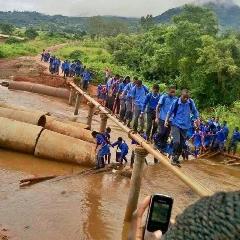Inclusive higher-education learning outcomes for rural and township youth: developing a multi-dimensional capabilities-based higher education Index – Miratho Project
Melanie Walker, Merridy Wilson-Strydom, Monica McLean, Ann-Marie Bathmaker, and Mikateko Hoppener
Funding: ESRC-DfID (Grant Ref: ES/N010094/1)
 Miratho
Miratho are informal bridges, usually constructed by community members during times of
floods or other natural disasters to get across from one village to another. These self-made bridges are usually dangerous, unstable and only the brave tend to use them. In particular, students who study outside their village may find themselves stranded and unable to go to school. When community members then build Miratho, opportunities are created for these students to access the schools of their choice. We have chosen the TshiVenda word ‘Miratho’ for our project name, because it symbolises the determination to access education even in the face of danger, and working with others to make progress.
Project aims
- To investigate how interaction and complex biographical, socio-economic, policy, and educational factors enable or inhibit pathways for rural and township youth to get in, get on, and get out of higher education, in terms of ‘learning outcomes’ achieved.
- To produce a normative multidimensional human capabilities-promoting higher-education learning outcomes Index.
Research questions
- How do disadvantaged youth from rural and townships schools access, participate in, and succeed in higher education, and then move into work?
- What contextual dimensions of economic, policy, social, and educational conditions enable or inhibit access, participation, and success?
- Which multi-dimensional higher-education learning outcomes that benefit individuals and society, are valued by stakeholders, including students?
- How can the capabilities approach be applied analytically to the multiple data sets in order to produce a multi-dimensional inclusive higher-education capabilities-based higher education Index?
- How can the Index be used to inform policy and practice interventions that confront the structural inequalities impacting on learning outcomes of students from challenging contexts?
- How can we develop an innovative theoretical approach for understanding inclusive learning outcomes in higher education, but with broader educational relevance in developing countries?
For more details, please visit the project website (www.miratho.com) or see the project summary document
(MIRATHO - Inclusive higher education learning outcomes for rural and township youth: developing a multi-dimensional capabilities-based higher education index)